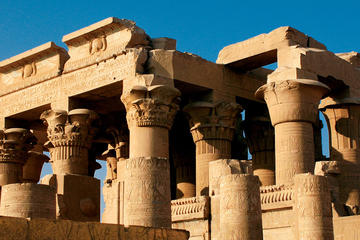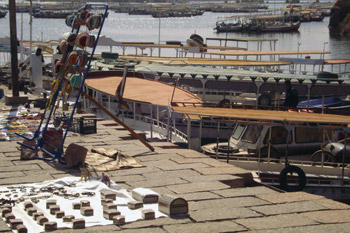
by W. Ruth Kozak
I am on a wooden wharf by the banks of the Nile River at Aswan, in Egypt with my travel companions. There are many small boats tied up along the river bank, their helmsmen eagerly awaiting passengers. We will be the only ones that day – ten of us: six travel writers, an Egyptologist, a tourism rep from Aswan and two burly escorts dressed in business suits.
Strewn along our path are collections of beads, carvings and other trinkets laid out on blankets. We are welcomed by a group of smiling, dusky-skinned men and boys who surround us . They are dressed traditionally in long striped cotton gelabyas, some wear white turbans. They show us the brightly coloured woven scarves, and other wares. “Please, buy!” They thrust out carvings cats and scarabs. “Very nice. Look, alabaster!”
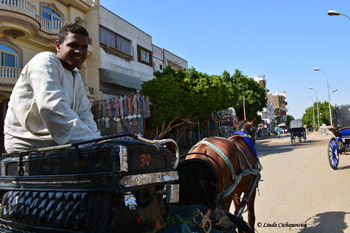 Unfortunately we have no time to bargain and buy souvenirs this morning. We’re on our way to board a boat that will take us to visit the island temple of Philae. Hanan, the Egyptologist explains, “These dark-skinned people are Nubians. They live in settlements along the river.” She tells us that because of the lack of tourists due to recent political unrest, these souvenir hawkers and boatmen are struggling to make a living. Hanan points out a settlement of yellow brick houses clustered under a sandy hill across the river. “That is one of their villages. They call it ‘Elephantine’, perhaps because the hill is shaped like an elephant.”
Unfortunately we have no time to bargain and buy souvenirs this morning. We’re on our way to board a boat that will take us to visit the island temple of Philae. Hanan, the Egyptologist explains, “These dark-skinned people are Nubians. They live in settlements along the river.” She tells us that because of the lack of tourists due to recent political unrest, these souvenir hawkers and boatmen are struggling to make a living. Hanan points out a settlement of yellow brick houses clustered under a sandy hill across the river. “That is one of their villages. They call it ‘Elephantine’, perhaps because the hill is shaped like an elephant.”
The Nubians are one of the oldest cultures in Africa and can trace their history back to before 7000 BC. Their name may have originated from an Egyptian word nebu, meaning “gold”. In antiquity, Nubia was a land of great wealth, gold mines, ebony, ivory and incense. Although much of their land was desert, the areas near the Nile were irrigated so it became known for its agriculture. They lived in the area of south Egypt and north Sudan and had their own dialect and traditions. Although most Nubians now speak Arabic, their language is the oldest recorded language of Africa though they didn’t develop a written language until late in ancient times.
 With our handsome young Nubian boatman at the helm we sail down the river. These boatmen are renowned for their skill as skippers and fishermen. Most of the small craft including the feluccas that sail on the Nile are commandeered by Nubians. The Nile is a vast river, much wider than I’d expected, and fast flowing.
With our handsome young Nubian boatman at the helm we sail down the river. These boatmen are renowned for their skill as skippers and fishermen. Most of the small craft including the feluccas that sail on the Nile are commandeered by Nubians. The Nile is a vast river, much wider than I’d expected, and fast flowing.
The descendants of the ancient Nubians still inhabit part of the area that was once ancient Nubia, but after the building of the Aswan High Dam in 1960, most of their ancestral lands were flooded uprooting Nubian farmers and fishermen. Today they are a marginalized people, living on the fringe of Egyptian society. They have been forced to settle in small communities along the Nile. The dam created a 500 mile long lake, Lake Nasser, which flooded ancient temples and tombs as well as hundreds of villages and farmland. The Nubian’s lives and culture were uprooted by this forcible eviction from their lands. Consequently they have felt ostracized. A new constitution promises to bring the Egyptian Nubians back to their original territories and hopefully, if this is enacted, it will improve their future.
 Nubia was always a land of mystery and legend. Many of the pharaohs of ancient times were Nubians. At the site of Memphis and Karnak there are Nubian monuments. In 747 BC the city of Thebes, near Karnak, was besieged and the Egyptians called on the Nubian king for protection. Thebes was rescued and for the next 100 years Nubian kings ruled in Egypt. Archaeologists have worked to excavate as many ancient sites as possible and managed to save over 5000 Nubian objects but many of the Nubian treasures still lie beneath the waters of Lake Nasser. One of the archaeological sites that was rescued and restored is Abu Simbal, at the far end of Lake Nasser. Another is the Temple of Philae, restored on a small rocky island once known as Apo, which means “ivory”.
Nubia was always a land of mystery and legend. Many of the pharaohs of ancient times were Nubians. At the site of Memphis and Karnak there are Nubian monuments. In 747 BC the city of Thebes, near Karnak, was besieged and the Egyptians called on the Nubian king for protection. Thebes was rescued and for the next 100 years Nubian kings ruled in Egypt. Archaeologists have worked to excavate as many ancient sites as possible and managed to save over 5000 Nubian objects but many of the Nubian treasures still lie beneath the waters of Lake Nasser. One of the archaeological sites that was rescued and restored is Abu Simbal, at the far end of Lake Nasser. Another is the Temple of Philae, restored on a small rocky island once known as Apo, which means “ivory”.
The scene is pastoral and serene as we cruise along the shore. Herds of goats and cattle graze and farmers plod along palm-shaded paths leading donkeys laden with baskets of produce or heaps of cut sugar-cane. An egret flies out of the reeds. It is easy to see how this river has been the life-stream of Egypt from antiquity. The river represented the god Osiris’ capacity to renew the earth and restore life. In ancient times, religious festivals were held as the Nile receded and when it rose toward its flood stage.
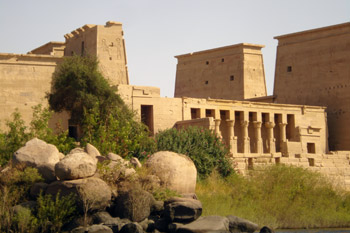 The boat rounds a bend in the river past a mound of giant stones that stand like a sentinel. Not far ahead I see the sand-stone buildings of the Temple of Philae fringed by a stand of palm trees.
The boat rounds a bend in the river past a mound of giant stones that stand like a sentinel. Not far ahead I see the sand-stone buildings of the Temple of Philae fringed by a stand of palm trees.
Philae was once the centre of commerce between Egypt and Nubia. The granite quarries nearby attracted a population of miners and stonemasons. When the first Aswan Low Dam was completed by the British in 1902, many ancient landmarks including the temple complex of Philae were in danger of being submerged. It was decided to relocate the temples piece by piece to nearby islands but instead the foundations were strengthened. In 1960 UNESCO started a project to try and save the temples from the destructive effects of the Nile waters. By then the rising water had submerged up to a third of the island’s buildings. Various methods were used to try and pump the water away but eventually every building was dismantled and transported to a nearby island situated on higher ground.
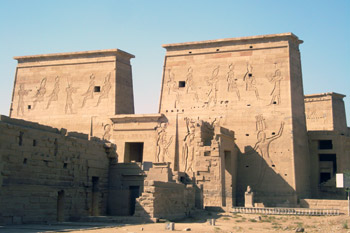 The temple complex was built during the Ptolemaic dynasty (380-362 BC). Its principal deity was Isis but there are shrines dedicated to other gods. The most ancient temple was one built for Isis, the goddess to whom the first buildings were dedicated. It was approached from the river through a double colonnade. Because it was supposed to be the burial place of Isis’s husband, Osiris, Philae was held in great reverence both by the Egyptians to the north and the Nubians in the south. Only priests could dwell there. On the walls inscriptions tell the story of Osiris and how he was murdered.
The temple complex was built during the Ptolemaic dynasty (380-362 BC). Its principal deity was Isis but there are shrines dedicated to other gods. The most ancient temple was one built for Isis, the goddess to whom the first buildings were dedicated. It was approached from the river through a double colonnade. Because it was supposed to be the burial place of Isis’s husband, Osiris, Philae was held in great reverence both by the Egyptians to the north and the Nubians in the south. Only priests could dwell there. On the walls inscriptions tell the story of Osiris and how he was murdered.
Our Egyptologist, Hanan’s enthusiasm and passion for her country’s history makes the past come to life as she tells the stories depicted on the hieroglyphics, how Isis took revenge on her husband, Osiris’s, murderer. “Osiris was slain by his brother Seth and discovered by Isis. She brought Osiris back to life.” The story of Osiris’ resurrection played an important part in the cult that became symbolic of the pharaohs of Egypt. Hanan explained the significance of Isis’ son, Horus, the falcon-headed god. Dead pharaohs were equated with Horus.
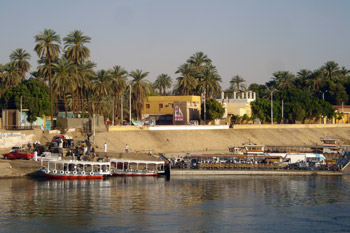 The Philae temple was closed in the 6thcentury AD by the Byzantine emperor Justinian. After that it became a seat of the Christian religion. Ruins of a Christian church were discovered on the site. Many of the sculptures and hieroglyphics on the walls of the temple were destroyed or mutilated by these early Christian inhabitants. Most of Horus’s statues were left unmarred but in many of the wall scenes, every figure is scratched out except that of Horus and his winged solar-disk, perhaps because the Byzantine Christians saw some parallel between Horus, the god’s son, and the stories of Jesus.
The Philae temple was closed in the 6thcentury AD by the Byzantine emperor Justinian. After that it became a seat of the Christian religion. Ruins of a Christian church were discovered on the site. Many of the sculptures and hieroglyphics on the walls of the temple were destroyed or mutilated by these early Christian inhabitants. Most of Horus’s statues were left unmarred but in many of the wall scenes, every figure is scratched out except that of Horus and his winged solar-disk, perhaps because the Byzantine Christians saw some parallel between Horus, the god’s son, and the stories of Jesus.
After our tour we return to our boat where the boatman is waiting to take us back to Aswan. The two escorts decide to entertain us by standing on the prow, playfully daring one another to keep their balance. The boat tilts and I wonder if one of them will plunge into the river, but the good-natured Nubian helmsman grins and keeps the craft on an even keel. It was memorable day on the river and I have learned so much of the history of these proud ancient people who once ruled Egypt as kings.
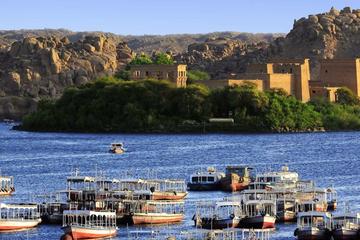
Guided Aswan Day Trip Philae and Kalabsha Temples and Nubian Museum with Lunch
If You Go:
♦ Temple of Philae: www.discoveringegypt.com/philae1.htm (history)
♦ Temple of Philae: en.egypt.travel/attraction/index/temple-of-philae (Egyptian Tourism)
♦ The Nubians: www.pbs.org/wonders/Episodes/Epi1/1_retel1.htm (history)
♦ Feluccas on the Nile: www.touregypt.net/featurestories/feluccas.htm
♦ Nubian music on a Nile cruise: www.tripadvisor.ca/LocationPhotoDirectLink-g294205-i15743621-Luxor_Nile_River_Valley.html
About the author:
Ruth was recently invited on a travel writer’s press trip to Egypt, a dream come true for her. The trip to Philae was one of many adventures including a special side-trip to Alexandria; the city planned by and dedicated to Alexander the Great. Ruth’s historical novel SHADOW OF THE LION will be published in August 2014. Book 1 is sub-titled “Blood on the Moon”. Book 2 “The Fields of Hades” will follow in 2016. You can read Ruth’s blogs for her novel at shadowofthelion.com or see her website at www.ruthkozak.com.
All photos by W. Ruth Kozak, except #2 Carriage Driver and #3 Nubian Boatman by Linda Cichanowicz.

